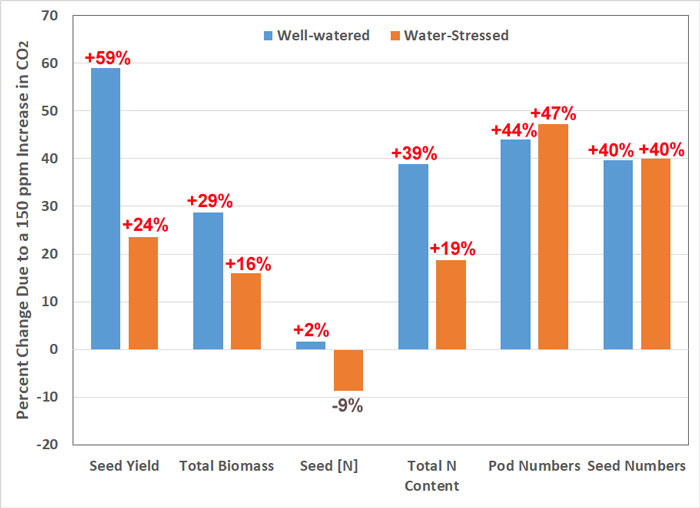| Tweet | Follow @co2science |
Paper Reviewed
Parvin, S., Uddin, S., Tausz-Posch, S., Fitzgerald, G., Armstrong, R. and Tausz, M. 2019. Elevated CO2 improves yield and N2 fixation but not grain N concentration of faba bean (Vicia faba L.) subjected to terminal drought. Environmental and Experimental Botany 165: 161-173.
Many researchers have explored the impact of changes in various environmental parameters on crop growth and yield in recent years, including combined changes in atmospheric CO2 and water supply. Such was the topic of a recent investigation by Parvin et al. (2019), who studied the response of faba bean (Vicia faba cv. Fiesta) to a 150 ppm enrichment in CO2 under well-watered and water-stressed conditions.
Their work was conducted at the Agriculture Victoria Research Plant Breeding Center in Horsham, Victoria, Australia in 2016. Using free-air CO2 enrichment (FACE) technology, the six scientists exposed faba bean crops to ambient (400 ppm) or elevated (550 ppm) CO2 levels under well-watered (soil maintained at 80% field capacity) until the reproductive phase. Thereafter, they induced terminal drought in half the crops in each CO2 treatment by withholding water until 30% field capacity was reached, maintaining this level of water stress through harvest.
And what was the result of these treatment conditions?
With respect to various growth and yield attributes, Parvin et al. found that elevated CO2 stimulated various growth and yield attributes, regardless of soil water conditions. As shown in Figure 1, under well-watered conditions elevated CO2 increased faba bean pod number, seed number, total biomass and seed yield by 44%, 40%, 29% and 59%, respectively. And although terminal drought had a negative impact on plant growth and yield attributes, under such water-stressed conditions elevated CO2 still improved the pod number, seed number, total biomass and seed yield by 47%, 40%, 16% and 24%, again respectively. What is more, in the combined elevated CO2 and drought treatment, the positive effects of elevated CO2 were powerful enough to fully mitigate the growth retarding influences of drought in terms of total plant biomass, seed yield, pod number, seed number and harvest index, which variables were not significantly different than plants in the control treatment of well-watered and ambient CO2.
Parvin et al. also investigated the nitrogen (N) response (content and concentration) of the faba bean plants across the different treatments. Here, they found that elevated CO2 increased the seed N concentration by a nonsignificant 2% under well-watered conditions, but decreased it by 9% under terminal drought. In contrast, elevated CO2 increased the total N content under both well-watered and water-stressed conditions by 39% and 19%, respectively.
In light of the above findings, it would appear that in the future, rising atmospheric CO2 will greatly stimulate the growth and yield of faba bean, especially in regions prone to water-stress. And with greater soil water contents thanks to CO2-induced enhancements in plant water-use efficiencies, the quality of faba bean harvest may also improve, especially in water-stressed regions, as the seed N concentration rises under elevated CO2 in consequence of increasing soil water content.

Figure 1. Percent change in seed yield, total plant biomass, seed nitrogen (N) concentration, total plant N content, pod numbers and seed numbers of faba bean (Vicia faba) plants due to a 150 ppm enrichment of atmospheric CO2 under well-watered (soil kept at 80% field capacity) or water-stressed (soil kept at 30% field capacity through the reproductive phases) conditions. Figure created using data presented in Table 1 of Parvin et al. (2019).




